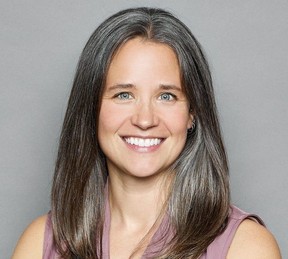Cervical cancer rates rising in Canada, but other countries are close to eliminating it
Between 2015 and 2019 cervical cancer rates in this country increased by 3.7 per cent a year.

Article content
Reviews and recommendations are unbiased and products are independently selected. Postmedia may earn an affiliate commission from purchases made through links on this page.
At a time when some countries are on track to eliminate cervical cancer, Canada is moving in the opposite direction.
For health experts and survivors, including Ottawa advocate Liz Ellwood, the trend is both shocking and unnecessary. Cervical cancer is highly treatable and preventable with an effective vaccine.
Recommended Videos
Ellwood became a vocal advocate for the HPV vaccine — which prevents the vast majority of cervical cancers — after she was diagnosed with the cancer two decades ago, when she was in her early 20s.
She survived, but the treatment left her unable to give birth, and she still experiences painful side-effects from radiation. “I am lucky to be alive,” she says. As an advocate she has met many women who were not as lucky.
“It is a horrible disease.”
Since then, a generation of teenage girls has been vaccinated against HPV (human papilloma virus), which significantly reduces their risk of developing cervical cancer. Teen boys later also became eligible for the vaccine. Those in-school vaccination programs, like many, were disrupted during the COVID-19 pandemic, but efforts are underway to close the gap. The first women to receive the HPV vaccine in Canadian schools are now close to 30.
Ellwood believes the vaccine should have been more widely accessible from the beginning to allow more people to get immunized. It is currently available free for students in grades 7-12, those up to Grade 12 who missed the school program and men who have sex with men up until age 27.
Still, the key factors contributing to the uptick in cervical cancer cases include lack of access to primary health care and less-than-robust cervical cancer screening programs for women in their 40s and 50s and beyond who were not vaccinated.
Rates of cervical cancer are not as high as some other cancers, notably breast cancer, which makes up one-quarter of cancer diagnoses in women in Canada. But cervical is now the fastest growing cancer among women in Canada, marking its first significant increase since the 1980s. And things could get worse before they get better.
“Cervical cancer rates going up is possibly one of the most frustrating things I have seen,” said Dr. Shannon Salvador, who is president of the Society of the Gynecologic Oncology of Canada. She treats patients at the Jewish General Hospital in Montreal.
Canada is among countries that have made it a goal to eliminate cervical cancer by or before 2040. Some countries — notably Australia and Sweden — are closing in on the target of fewer than four cases per 100,000 population, which is considered elimination. But Canada’s rate is more than double that and rising.
Between 2015 and 2019, cervical cancer rates increased in Canada by 3.7 per cent a year, according to a recent report from the Canadian Cancer Society, which calls it the first significant increase in cervical cancer rates since 1984. More than 1,500 people a year are diagnosed with cervical cancer.
Salvador says she fears cervical cancer rates will increase even more rapidly since those statistics don’t include the period of the pandemic, which disrupted the health system and delayed screening and diagnosis for many illnesses, including cancer. Key drivers of the increase in cervical cancer are the shortage of family physicians and the lack of robust screening programs across the country, she says.
Women and some men under the age of 30 have been vaccinated against HPV, reducing their risk of cervical cancer, but, for women between 30 and about 55 or older, early detection through screening continues to be the key to reducing cervical cancer rates, Salvador says.

Poor access to primary care in much of Canada and a screening program that doesn’t reach many people add to the risk of cervical cancers being detected at later stages. The risks in rural parts of the country — where access to primary care and screening is often more difficult — are higher.
Salvador wants to see all provinces and territories switch from the traditional pap smear screening test to an HPV test, something already done in Ontario. HPV testing is considered more sensitive, meaning it is better at detecting high-risk HPV infection before abnormal cells develop. It also has the potential to be self-administered, something Salvador says will increase access, especially for those in remote areas or without good access to primary care.
For now, she and other specialists in gynecological oncology are seeing fewer cases of pre-cancers being identified and more advanced-stage cancers.
In Australia, which is on track to eliminate cervical cancer, the screening system is “much more robust,” meaning it tracks and contacts women to let them know when they need screening, she notes.
Cervical cancer is not the only gynecological cancer of concern, she says. In Canada, nine women a day are diagnosed with ovarian cancer, one of the deadliest cancers involving women and one for which there is no screening. And more than 8,500 women will be diagnosed with uterine cancer this year.
Salvador says advanced stage gynecological cancers are increasingly being diagnosed in emergency departments after symptoms have progressed.
“An emergency room is a terrible location to be told you have cancer,” she said.
A new worry is the spillover from health research cuts in the United States to issues related to women. Women specific health research already lags behind other research, Salvador says, and the cuts in the U.S. could create a period of stagnation when it comes to new treatments and innovations for gynecological cancers.
“It is really disheartening.”
Ellwood says she is hopeful that new generations of women will not have to face what she did.
Recently, Ellwood’s daughter — conceived using a donor egg and carried by a surrogate — received her HPV vaccine. Ellwood says she cried.
“I felt so relieved. It was a really good feeling.”
Our website is your destination for up-to-the-minute news, so make sure to bookmark our homepage and sign up for our newsletters so we can keep you informed.













Postmedia is committed to maintaining a lively but civil forum for discussion. Please keep comments relevant and respectful. Comments may take up to an hour to appear on the site. You will receive an email if there is a reply to your comment, an update to a thread you follow or if a user you follow comments. Visit our Community Guidelines for more information.